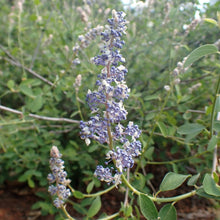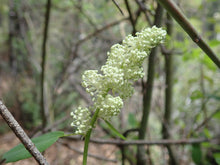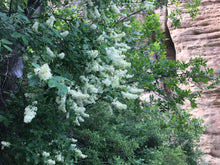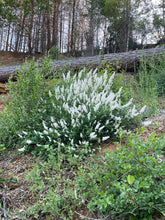
Ceanothus integerrimus
Count yourself lucky if you stumble upon a hillside of deerbrush in bloom, with its clusters of pale-blue flowers filling the air with a fragrance of honey poco-picante (slightly spicy). Due to its widespread distribution, it is a highly variant shrub. In some locations, it is deciduous with a tall, upright form, while in others it can be semi-evergreen and mounding or even weeping. In any case, not only does this lovely shrub appease the eyes of gardeners, but it's a pollinator powerhouse, including playing host to dozens of native species of moths and butterflies. Plus, like all ceanothus species, its roots have the ability to fix nitrogen in the soil, inadvertently adding nutrients for other plants to use and making it an important part of forest regeneration after a wildfire.
- Plant type/canopy layer: deciduous to semi-evergreen, perennial, large shrub
- Size at maturity: 3-14' tall, 5-12' wide
- Light requirements: full sun, part sun/part shade
- Moisture requirements: dry soil, can tolerate some moisture, esp if well-drained
- Bloom time: May - August
- Growth rate/ease: medium growth rate, moderately easy to grow
- Wildlife support: flowers provide nectar to adult butterflies, bees and other insect pollinators; stems and seeds favored by deer, porcupines and quail; overall plant attracts and supports beneficial and other pest-eating insects and is a caterpillar host and larval food source for native butterflies and moths such as the Brown Elfin, the California Tortoiseshell and the Pale Swallowtail.
- Native habitat/range: grows on dry slopes, ridges and forest openings, often as part of an evergreen forest, chaparral or oak woodland, at low to mid-elevations, predominantly in the Siskiyous of southwestern Oregon, as well as mixed forests both east and west of the Cascades and isolated areas of the Columbia River Gorge in Oregon and Washington, then south throughout California and into parts of Arizona and New Mexico. Portland Plant List - no.
- Special features & uses: drought-tolerant; landscape uses include pollinator gardens, woodland gardens, rock gardens, habitat hedgerows, bank stabilization and erosion control; medicinally, indigenous people have been known to use the branches to treat women after childbirth; many groups have also used the flexible shoots for weaving. All parts contain high levels of saponins, which can be crushed and mixed with water to produce a gentle soap and ranchers claim that cattle do well when this species is part of their grazing.
Gardening with Deerbrush: Like many native plants, this species can be tough-as-nails once established, provided it’s planted in the right place. It is recommended for exposed banks, hillsides, rockgardens or on the edges of woodland gardens in soils that drain relatively quickly. Imagine it blooming along the edge of your madrone or Ponderosa pine canopy, coupled with serviceberry, snowberry, and herbaceous beauties like farewell-to-spring, foothill sedge and sticky cinquefoil. Or use it as part of a low-maintenance habitat-hedgerow, screening your relaxing back patio and providing pollination and soil remediation services to the rest of your garden. In the right place, it will be tremendously low-maintenance, requiring little to no supplemental water; no more than 1-2 times per month from June-August once established. You can prune out rangy branches in late summer to maintain a compact and tidy appearance if you wish - but it’s not necessary and, of course, nature probably prefers it wild.
Photo Credit 1: © Nicholas Wei, some rights reserved (CC-BY-SA)
Photo Credit 2: © Nolan Exe, some rights reserved (CC-BY)
Photo Credit 3: © marek, some rights reserved (CC-BY)
Photo Credit 4: © Amelia Tauber – some rights reserved (CC BY)







